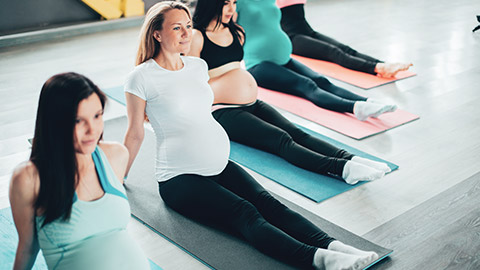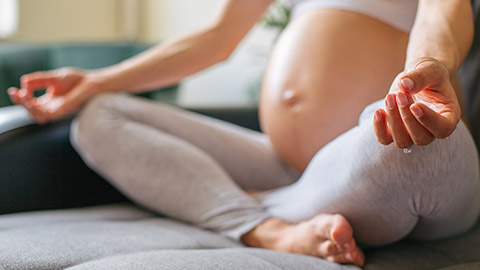In this topic, we focus on pregnancy and the effects it can have on mothers to be and their participation in sport and exercise. You will learn about:
- Pregnancy and benefits of exercise
- Prenatal changes
- Postpartum changes
- General exercise guidelines.
Terminology and vocabulary reference guide
As an allied health professional, you need to be familiar with terms associated with basic exercise principles and use the terms correctly (and confidently) with clients, your colleagues, and other allied health professionals. You will be introduced to many terms and definitions. Add any unfamiliar terms to your own vocabulary reference guide.
Activities
There are activities throughout the topic and an end of the topic automated quiz. These are not part of your assessment but will provide practical experience that will help you in your work and help you prepare for your formal assessment.

Pregnancy is grouped into three trimesters, and usually occurs over a 40-week period. Previously, it has been thought that exercising during pregnancy was too high risk, however research has shown, if commenced at an appropriate stage of pregnancy and planned with a qualified allied health professional, exercise can have several benefits for both mother and child. These benefits support the female in managing the bodily changes that occur during pregnancy and preparing for childbirth. For example,
- Reduced risk of complications during pregnancy
- Reduced risk of complications during labour
- Increased rate of recovery post-birth
- Strengthens the heart and blood vessels
- Decreased blood pressure (BP can rise during pregnancy, potentially giving rise to BP related issues)
- Improved cardiovascular fitness
- Relief from backache and improves posture by strengthening muscles in the back, glutes, and thighs
- Increased self-esteem
- Reduced constipation by accelerating movement in the intestine
- Improved sleep as exercise helps relieve the stress and anxiety that may cause feelings of restlessness at night
- Decreased the risk of preeclampsia and gestational diabetes
- Decreased susceptibly of diabetes occurring in the child
- Boost to foetal brain health
- Promotes healthy weight gain.
It is important to maintain some form of physical activity, coupled with a healthy diet for the overall wellbeing of the pregnant individual. However, due to copious amounts of research, there are many studies with different ideas on which foods or exercise routines are effective or ineffective for the mother and the unborn child. A good rule of thumb is to completely avoid it if unsure and seek further guidance from a medical professional.

During the course of pregnancy, women will experience several changes to their body that will impact them during exercise. Within the nine months of pregnancy, a woman’s body will experience physical transformations, some being more obvious than others, such as a growing belly. Others may not be so obvious, such as hormonal changes that affect performance and functionality. Let us have a look at some of the physical changes that pregnant women experience that will need to be considered when implementing safe and effective exercise programs.
Less lung capacity
As the foetus grows within the womb, the body will adapt to allow room, pushing up organs such as the lungs. Because of this, there may be difficulty in aerobic exercises as there is a decreased availability of oxygen. It is essential to keep a close eye on symptoms of breathlessness during training and modify the intensity accordingly.
Increase in the volume of blood
With a baby now depending on the woman’s body for nourishment, the heart increases the volume of blood by 30% – 50%, speeding up the heart rate, therefore, putting an added stress on the heart. This in turn, will need to be considered during an intense exercise program, to ensure the heart is not over worked.
Joints and flexibility
The hormone relaxin is secreted during pregnancy. This hormone increases joint laxity (joint flexibility) which poses a greater risk of joint injury due to increased flexibility of the stabilising connective tissues (muscles and ligaments) surrounding a joint.
It is important to ensure that stretches are not be taken to the point of maximum resistance including movements that require deep flexion or extension. When implementing an exercise program, joints can be kept safe by avoid using activities that require jumping or jarring motions, rapid changes in direction, or ballistic movements such as bouncing motions.
Balance
One of the obvious physical changes during pregnancy is the growth of the belly and weight gain. This growth becomes progressively more strenuous as the weight, predominantly in the front of the body (the belly), shifts the centre of gravity (COG).
Typically, a woman can put on 11-18 kilos by their third trimester, adding stress to areas such as joints and muscles that can result in a higher risk of falls. The centre of gravity may affect the following:
- Posture
- Balance
- Stability
- Coordination.
The centre of gravity is also altered by the hormone relaxin as it can increase lumbar lordosis (the arch in the lower back). This factor, along with joint laxity, can also predispose pregnant women to changes in balance and increasing occurrences of back pain. To support the shift of balance, it is suggested to avoid exercises that may cause abdominal trauma and exercise that involve rapid changes of directions such as twists, turns and sudden movements. It is also recommended for added precautionary measures, the use of a maternity belt can also be placed to alleviate any pressure on the lower body muscles, therefore lessening body aches. Another consideration when exercising that will help avoid falling or slipping, is to perform exercises on stable flooring such as on a wooden floor or tightly carpeted surface, this will help to reduce shock to the body and provide a stable footing for balance.
Temperature control
The core temperature of the mother is related to exercise intensity and duration, it is important to note that acute effects of exercise on the foetus includes increases in temperature, heart rate and oxygenation. Data on animals have shown abnormalities with maternal core temperate above 39⁰C, studies conducted on humans have shown an increase in the incidence rate of neural tube defects in relation to maternal high fever. It is therefore of the utmost importance to not overheat a pregnant body; the well-being of the baby should be the prime consideration!
To support this, it is advised during exercise, that a pregnant woman stay very well hydrated, avoid exercising in heat and humidity, wear light, breathable, loose fitting clothing, stay well ventilated in hot weather and avoid saunas and steam baths.

The term postpartum refers to the mother just after giving birth. This period is a sensitive period to commence exercise, it is recommended that exercise should start off slow and the increase of intensity may very well depend on the type of delivery, (c-section or vaginal birth). In any case, before implementing any type of exercise programs for your clients after childbirth, it is essential they consult with a medical professional and give them the green light to go ahead. Postpartum exercise is as beneficial as exercising while pregnant for both physical and mental health. In fact, it even helps to fend of postpartum depression. The following muscles areas are significant to a postpartum body and it is crucial to not overlook these areas when implementing an exercise program for a woman after childbirth.
- Pelvic floor muscles
- Rectus abdominus muscles.
Pelvic floor muscles
These muscles have gone through a huge journey and deserve some love and care. The pelvic floor muscles have worked harder on the body during pregnancy than normal, as they have been required to support the weight of a growing baby. In the meantime, the hormone relaxin has been taking effect and can still be present after giving birth. This hormone has enabled the softening of the pelvic floor muscles to allow them to stretch and prepare for childbirth. Due to these reasons, and the muscle being further stretched during labour, the pelvic floor muscles can be severely weakened. It is important to maintain the strength in these muscles as they help in stabilising the spine (with help of the abdominal muscles), assist in emptying the bladder and can also prevent medical issues such as urine leakage and a prolapse. This when the bladder and uterus are no longer correctly positioned due to the lack of support from the pelvic muscles and they fall downwards towards the vagina. Take a look at the following video from the Continence Foundation of Australia where it explains the pelvic floor muscles and their function along with how to strengthen them through exercise.
Separation of rectus abdominis
Women will experience abdominal separation during pregnancy, this is also referred to as diastasis recti. The rectus abdominis (abdominal muscles) spread apart at the linea alba (the stomach midline), this occurs to accommodate the growing baby which is pushing up against the abdominal wall. Though this change in the body occurs during the course of pregnancy, the muscles can remain separated for some time afterwards. There are exercises that can be implemented as a part of an exercise program after giving birth, there are also exercise which should be avoided during this time in order to not further enhance any division of the abdominal muscles. Please note, it is essential to consult with a medical practitioner before starting any postnatal exercise program. The following video demonstrates a few handy hints to help with the diastasis recti that remains post pregnancy.

If a pregnant woman has exercised before becoming pregnant, it is most likely that they will be able to stick to the same routine they were originally applying. Pregnancy is not, however, the time to test the boundaries or pick up a new exercise activity, especially if it is high intensity or risky. It is important to remember that pregnancy places a large amount of responsibility on the individual who is pregnant, and it is vital to be best informed. Women who have not exercised prior to pregnancy, or are newcomers to exercise in general, should discuss an exercise program with their physician to ensure they are better equipped with the knowledge to effectively pick up a safe and effective exercise routine.
During pregnancy, women can continue to exercise and derive health benefits even from mild to moderate exercise routines. Moderate intensity means a woman can comfortably hold a conversation throughout the workout, without pausing for a breath. RANZCOG (The Royal Australian and New Zealand College of Obstetricians and Gynaecologists) states that women should get at least 150-300 minutes of moderate-intensity aerobic physical exercise per week. This equates to approximately 30 minutes of exercise on most days, without exceeding 60 minutes or more in on session, unless the intensity is relatively light. Regular exercise, at least three times per week is preferable to intermittent activity.
Little solid data exists on humans to indicate that pregnant women should limit exercise intensity and lower target heart rates because of potential adverse effects. However, it must be recognised that certain exercises do carry with them several risks that if ignored may result in foetal distress.
Exercises which may be performed

Non-weight bearing exercises such as cycling or swimming will minimise the risk of injury and facilitate the continuation of exercise during pregnancy. Weight-bearing exercises such as hiking, jogging, walking, or climbing stairs may under some circumstances be continued at intensities similar to those prior to pregnancy. Depending on the type of exercise performed, pregnant women should stop exercising when fatigued and not exercise to exhaustion.
Some exercises which may be considered safe, even for beginners include:
- Swimming
- Jogging
- Cycling – outdoors or on a stationary bicycle
- Walking
- Pilates
- Muscle strengthening exercises, including pelvic floor exercises
- Exercise in water (aquarobics)
- Yoga, stretching, and other floor exercises
- Pregnancy exercise classes.
Over time, there has been many studies that have highlighted the benefits of water-based experiences in pregnancy. These have shown water can decrease mothers heart rate by up to 10 bpm and cause foetal heart rate changes to be less dramatic. This occurs as water conducts heat 25% faster than air so core temperature will not rise as quickly. Balance and co-ordination concerns are eliminated because of the support of the water, pressure of water also decreases the venous pooling effect helping to reduce the effects of swelling during pregnancy. Engaging in water-based activities is one of the many way’s women can experience a better quality of life during pregnancy.
Additional benefits for water-based activity include:
- Control of body weight
- An increase in the level of amniotic fluid
- Decreased need for analgesia (painkillers)
- Decreased levels of oedema Increased diuresis
- A substantial reduction in arterial pressure
- Reduced impact on articulations
- A reduced amount of back pain
- A reduction in postpartum depression
- Psychological benefits (improved well-being, satisfaction, self-confidence, and body awareness)
Despite the many benefits of exercise, there are several barriers which hinder women to exercise during this time in her life. Some barriers include physical discomfort, a lack of time, fatigue, and/or the lack of knowledge in exercise guidelines, and how to exercise safely.
Exercises which should be avoided
Some women and physicians are concerned that regular maternal physical activity during pregnancy may cause miscarriage, premature delivery, poor foetal growth, or musculoskeletal injury, however, for normal pregnancies- these concerns have not been substantiated. All mothers want the best possible health for themselves and their babies, however in order to achieve this, it is important to be aware of activities which increase the risk of adverse effects on the child.
The following table presents examples of exercises which should be avoided and why.
| Exercise | Reasons to avoid |
|---|---|
| Abdominal exercises | Abdominal exercise should be avoided for those mothers who have separation of the rectus abdominus (typically occurring in 30% of women). |
| Heavyweight training | Heavy weight training places large amounts of stress of the muscles and bones and tends to promote clients to hold their breath. This causes a rise in blood pressure (which is already elevated due to being pregnant) which can promote dizzy spells and result in fainting. |
| Complex yoga poses |
Increased tendency to hold the breath, elevating BP and promoting dizzy spells which could result in fainting. Promote further exhaustion through performing complex muscular movements and poses. |
| Exercises in the supine position (lying on your back) | These should be avoided, particularly after the first trimester, due to the uterus compressing the vena cava (major blood vessel) and affecting blood flow, and there for oxygen and nutrient supply, to the foetus. |
| Exercises in the prone position (lying on your stomach) |
A number of associations such as the National Academy of Sports Medicine (NASM) have advised to avoid exercises which involve the mother directly lying on her stomach. These can place Increased pressure directly onto the unborn child which may also be uncomfortable as the baby bump begins to grow. |
| Activities which have a high chance of falls such as horse riding, cycling or quad biking. | Activities like this should be avoided where possible, to decrease the risks of accidents or injury to both the mother and unborn child. Cycling, especially during the second and third trimesters, should be avoided because of changes in balance and the risk of falling. |
| Activities which affect the centre of gravity (COG) |
Participation in activities which require rapid movements, changes in direction and levels of balance and coordination should be avoided as these will be increasingly challenging for a pregnant mother and pose a greater increased risk of falls. Exercises should be done on a wooden floor or tightly carpeted surface to reduce shock and provide a sure footing, further reducing the potential for loss of balance and falls. |
| Activities conducted at high altitude (typically above 2,500m) | Activities performed at high altitude which result in altitude sickness can reduce foetal oxygen supply posing harm to the development of the unborn child. These can also induce shortness of breath, chest pain, promoting light-headedness, and weakness. These should be avoided, particularly in non-acclimatised women. |
| Power/ plyometric training | Training that includes ballistic movements such as jerky, bouncy motions should be avoided as relaxin’s effect on the joints and their supporting ligaments, poses a greater risk of damage or injury. |
| Activities involving deep flexion or extension of joints | These should be avoided due to connective tissue laxity and the increased risk of joint injury. |
Important - Women should avoid exercise in the supine position (lying on the back) after the first trimester, as exercising in supine position may affect blood flow to the baby due to the enlarging uterus compressing the vena cava reducing cardiac output, reducing oxygen (O2) delivery to both baby and mother. If dizziness or light-headedness occurs, advise the mother to roll onto her left immediately, and slowly sit up. Prolonged periods of motionless standing should also be avoided.
Exercise readiness considerations

When undertaking an exercise regime, both mother and trainer should be aware of the following considerations:
Balance: with an additional 11-18 kilos to accommodate for, the centre of gravity will shift and effect balance. This puts the mother to be at a greater risk of falls, therefor exercise selection should be wisely considered.
Energy intake: pregnancy requires an additional 300kcal/day in order to maintain metabolic homeostasis. Thus, women who exercise during pregnancy should be particularly careful to ensure an adequate diet.
Temperature control: acute effects of exercise on the foetus include increases in temperature, heart rate and oxygenation, this translates from the core temperature of the mother which is related to exercise intensity and duration. Will the well-being of the baby being prime concerns, pregnant woman exercising in the first trimester should augment heat dissipation by considering the following:
- Stay well hydrated
- Avoid exercise on hot, humid days
- Wear light, breathable, loose-fitting clothing
- Use fans during hot weather
- Avoid saunas and steam baths.
Exercise guidelines
Current guidelines suggest that the duration of exercise should not exceed 15 minutes. Exercise intensity should raise the maternal rate to no higher than 144bpm, as the baby’s heart rate (HR) is already high, working at levels above this can promote foetal distress. Foetal distress, which is indicated by a marked decrease in the baby’s heart rate, can occur due to decreased uterine blood flow during exercise, causing blood to be shunted away from the foetus to the working muscles. This may occur in response to exercise, depending on the stage of pregnancy, or due to the exercise intensity, duration, and type. The clinical significance of these changes in foetal heart rate observed is uncertain, however, It is incredibly important to monitor exercise intensity
The most marked increase in foetal weight occurs in the third trimester, intense exercise at this stage can result in decreased birth weight and/or a shorter than normal gestation period. In some studies, intense exercise by the mother during pregnancy has been noted to result in a small decrease in the average birth weight of their babies. Although there are no reports of any adverse outcomes on pregnancy, there is also a "theoretical" risk of premature labour associated with the level of certain hormones causing uterine irritability, but these have not been seen in practice.
For women who trained regularly before pregnancy regular exercise is preferable to sporadic sessions. As a general rule, mild to moderate exercise for 20 to 40 minutes, three times a week, at a heart rate up to approximately 144 beats per minute, has been recommended. Prescriptive guidelines however can be unhelpful (producing frustration, rebellion, and guilt in many physically active women), and now it is generally considered as important to encourage pregnant women to modify the intensity of their exercise according to their own feelings of fatigue. Exhaustive exercise should be avoided. Unfortunately, there is a lack of clear scientific evidence to rely on at higher exercise intensities and further research is needed. Pregnancy is not the time to commence anything other than a very mild exercise programme, those serious athletes who wish to continue intense training should be individually and carefully counselled as to the best approach for them.
The cool-down phase of a workout should be gradual, as foetal risk may be greatest immediately after the conditioning portion of a workout.
Contra-indications for exercise
These recommendations are intended for women who do not have any additional risk factors for adverse maternal or perinatal outcomes. Several medical and obstetric conditions may require modification of these guidelines. The following conditions should be considered contraindications to exercise during pregnancy and require medical clearance prior to undertaking physical activity:
- Pregnancy-induced hypertension
- Pre-term rupture of membranes, pre-term labour during the prior or current pregnancy or both
- Incompetent cervix
- Persistent second or third trimester bleeding
- Intrauterine growth retardation
- Multiple gestations.
Exercise can be uncomfortable, but it should not cause serious implications for overall health. It is important to cease exercise immediately and consult with a doctor or obstetrician if at any time during the exercise session the women experiences or feels:
- Faint
- Dizzy
- Unusually short of breath
- Vaginal bleeding
- Palpitations
- Blurred vision
- Headache
- Chest pain
- Unusual muscle weakness
- Calf pain or swelling
- Decreased foetal movement
- Amniotic fluid leakage.
Pregnancy is not a time for serious competition. The intensity of exercise should be regulated by how hard a woman believes she is working. Moderate to hard is quite safe for a woman who is accustomed to this level of exercise. There is no indication that mild-moderate exercise during pregnancy is harmful to foetal growth and development or causes reduced foetal mass, increased perinatal or neonatal mortality, or physical or mental delay. A healthy woman with a normal pregnancy may either continue her regular exercise regimen or begin a new exercise program during pregnancy. For each individual’s particular exercise prescription and its duration, it is vital to check with the physician to ensure it is suitable. For further information regarding recommendations during pregnancy, visit The American Congress of Obstetricians and Gynaecologists (ACOG).
In this topic, we focused on pregnancy and the effects it can have on mothers to be and their participation in sport and exercise. You learnt about:
- Pregnancy and benefits of exercise
- Prenatal changes
- Postpartum changes
- General exercise guidelines.

